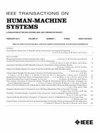A Multidataset Characterization of Window-Based Hyperparameters for Deep CNN-Driven sEMG Pattern Recognition
IF 3.5
3区 计算机科学
Q2 COMPUTER SCIENCE, ARTIFICIAL INTELLIGENCE
引用次数: 0
Abstract
The control performance of myoelectric prostheses would not only depend on the feature extraction and classification algorithms but also on interactions of dynamic window-based hyperparameters (WBHP) used to construct input signals. However, the relationship between these hyperparameters and how they influence the performance of the convolutional neural networks (CNNs) during motor intent decoding has not been studied. Therefore, we investigated the impact of various combinations of WBHP (window length and overlap) employed for the construction of raw two-dimensional (2-D) surface electromyogram (sEMG) signals on the performance of CNNs when used for motion intent decoding. Moreover, we examined the relationship between the window length of the 2-D sEMG and three commonly used CNN kernel sizes. To ensure high confidence in the findings, we implemented three CNNs, which are variants of the existing models, and a newly proposed CNN model. Experimental analysis was conducted using three distinct benchmark databases, two from upper limb amputees and one from able-bodied subjects. The results demonstrate that the performance of the CNNs improved as the overlap between consecutively generated 2-D signals increased, with 75% overlap yielding the optimal improvement by 12.62% accuracy and 39.60% F1-score compared to no overlap. Moreover, the CNNs performance was better for kernel size of seven than three and five across the databases. For the first time, we have established with multiple evidence that WBHP would substantially impact the decoding outcome and computational complexity of deep neural networks, and we anticipate that this may spur positive advancement in myoelectric control and related fields.用于深度 CNN 驱动的 sEMG 模式识别的基于窗口的超参数多数据集特性分析
肌电假肢的控制性能不仅取决于特征提取和分类算法,还取决于用于构建输入信号的基于动态窗口的超参数(WBHP)之间的相互作用。然而,这些超参数之间的关系以及它们在运动意图解码过程中如何影响卷积神经网络(CNN)的性能,尚未得到研究。因此,我们研究了用于构建原始二维(2-D)表面肌电图(sEMG)信号的各种 WBHP(窗口长度和重叠)组合对用于运动意图解码的 CNN 性能的影响。此外,我们还研究了二维 sEMG 窗口长度与三种常用 CNN 内核大小之间的关系。为了确保研究结果的高度可信性,我们实施了三个 CNN(现有模型的变体)和一个新提出的 CNN 模型。我们使用三个不同的基准数据库进行了实验分析,其中两个来自上肢截肢者,另一个来自健全受试者。结果表明,CNN 的性能随着连续生成的 2-D 信号之间重叠度的增加而提高,与无重叠度相比,75% 的重叠度带来了 12.62% 的准确率和 39.60% 的 F1 分数的最佳改善。此外,在所有数据库中,内核大小为 7 的 CNN 性能要优于 3 和 5。我们首次通过多种证据证明,WBHP 会对深度神经网络的解码结果和计算复杂性产生重大影响,预计这将推动肌电控制和相关领域的积极进步。
本文章由计算机程序翻译,如有差异,请以英文原文为准。
求助全文
约1分钟内获得全文
求助全文
来源期刊

IEEE Transactions on Human-Machine Systems
COMPUTER SCIENCE, ARTIFICIAL INTELLIGENCE-COMPUTER SCIENCE, CYBERNETICS
CiteScore
7.10
自引率
11.10%
发文量
136
期刊介绍:
The scope of the IEEE Transactions on Human-Machine Systems includes the fields of human machine systems. It covers human systems and human organizational interactions including cognitive ergonomics, system test and evaluation, and human information processing concerns in systems and organizations.
 求助内容:
求助内容: 应助结果提醒方式:
应助结果提醒方式:


